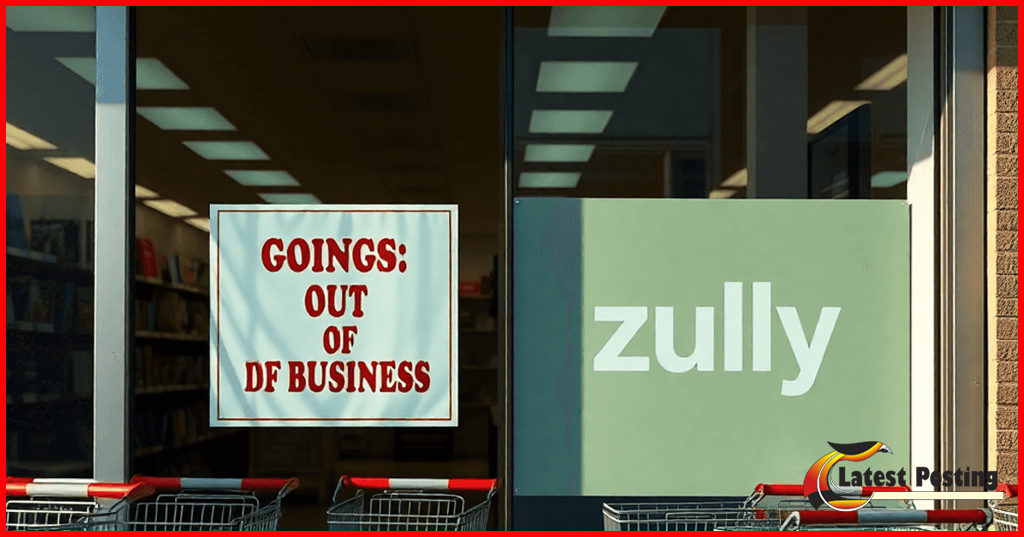Zulily, once a shining star in the online retail space, recently made headlines with its closure announcement. Known for its unique offerings in children’s and women’s apparel, Zulily was founded in 2010 and quickly became a household name, even going public by 2013. However, on December 27, 2023, the company revealed it would be winding down operations—a move that left many asking: What happened to Zulily?
Exploring the factors behind Zulily’s closure is crucial to understanding the volatile nature of the online retail industry. This article delves into the reasons behind this downfall, from fierce competition with giants like Amazon and fast-fashion disruptors such as Shein and Temu, to financial hurdles that proved insurmountable.

In this article, we will explore:
- A comprehensive look at Zulily’s rise and fall
- The challenges that plagued its journey
- Details about the closure announcement and liquidation process
- Insights into how employees and customers are affected
- Lessons for future online retailers navigating similar challenges
Through this exploration, we aim to offer valuable insights into not only what happened to Zulily but also what other businesses can learn from its story.
The Rise and Fall of Zulily
Zulily’s journey began in 2010, founded by former Blue Nile executives, Mark Vadon and Darrell Cavens. Their vision was to create an online retail space that offered daily deals on an array of products, including children’s and women’s apparel. This unique approach capitalized on urgency and exclusivity, drawing a substantial customer base eager for fresh finds at discounted prices.
The company quickly gained traction, riding the wave of e-commerce growth with its innovative flash sales model. By 2013, Zulily had gone public, raising $253 million in its initial public offering (IPO). This move marked a significant milestone as the company’s valuation soared to approximately $9 billion at its peak. Such rapid growth was a testament to Zulily’s ability to capture the market with its appealing business strategy.
Key milestones in Zulily’s success story:
- 2010: Establishment of Zulily with a focus on flash sales.
- 2013: Successful IPO and massive increase in market valuation.
- Peak Valuation: At around $9 billion, demonstrating significant investor confidence.
While these achievements were noteworthy, they also came with their share of challenges. The landscape of online retail is notoriously competitive, with giants like Amazon continually pushing boundaries and emerging players like Shein catering to similar demographics. Despite its early successes and strategic marketing endeavors, Zulily began struggling against these formidable competitors.
This section chronicles the pivotal moments that defined Zulily’s rise in the retail industry and sets the stage for understanding the factors that led to its eventual decline. The company’s story serves as a compelling case study on how rapidly changing market dynamics can affect even those businesses that initially seem unstoppable.
Challenges Faced by Zulily in the Competitive Retail Landscape
In a marketplace filled with large retail companies and agile newcomers, Zulily found itself navigating through difficult times. Retail competition proved to be a strong opponent, with giants like Amazon changing consumer expectations around delivery speed and product variety. The appeal of fast fashion brands such as Shein and new players like Temu added another layer of complexity, capturing the market’s interest with trendy, affordable options.
The financial situation for Zulily became increasingly tough as revenues began to decline. Despite efforts to boost sales through aggressive online marketing campaigns and promotions, the company struggled to maintain its profitability. Faced with shrinking profit margins, Zulily was unable to keep up with competitors who had mastered cost efficiencies and economies of scale.
Several factors contributed to the company’s financial struggles:
- Price Wars: In an attempt to stay competitive, Zulily often engaged in price reductions that further squeezed profit margins.
- Shifting Consumer Preferences: As shoppers leaned towards instant gratification and quick delivery options offered by rivals, Zulily’s unique model of limited-time sales events started losing its appeal.
- Operational Costs: Maintaining a strong supply chain while offering diverse and frequently changing inventory proved costly, impacting overall sustainability.
These issues were not isolated incidents but rather indicative of broader challenges within the retail sector. As consumers became savvier and more demanding, retailers like Zulily faced mounting pressure to innovate or risk becoming irrelevant. The struggle to balance customer acquisition costs with lifetime value highlighted the need for strategic changes that perhaps came too late for Zulily.
Understanding these dynamics offers valuable insights into the complex relationship between staying relevant and maintaining financial health in today’s fast-paced retail environment.
The Closure Announcement and Liquidation Process
The Zulily closure announcement on December 27, 2023, marked a significant turning point for the online retail giant. This decision to wind down operations was attributed to a combination of challenges, including a difficult business environment and financial instability. Despite its innovative approach in the e-commerce space, Zulily found itself unable to sustain its business model amidst growing competition and declining revenues.
Regent’s Role in the Transition
Regent, a private equity firm, played a pivotal role in this transition. Having acquired Zulily in May 2023 from Qurate Retail Group, Regent took charge of overseeing the liquidation process. The acquisition was part of an effort to revitalize Zulily’s operations; however, it quickly became evident that the hurdles faced were insurmountable under the prevailing market conditions.
Structured Approach to Liquidation
Regent’s involvement in managing the liquidation process details ensured a structured approach to winding down operations. Their strategy included coordinating with Douglas Wilson Companies, specialists in handling orderly liquidations. This collaboration aimed to minimize disruptions for both employees and customers while ensuring compliance with all regulatory requirements.
Impact on Employees and Customers
The impact of this closure extended beyond just financial loss. Employees faced uncertainty and job losses as part of the company’s downsizing efforts throughout the year. Meanwhile, customers expressed concerns over pending orders and refunds. A commitment was made by Zulily to fulfill or refund these orders by January 22, 2024, reflecting an effort to maintain customer trust during this tumultuous phase.
Understanding what happened to Zulily provides valuable insights into the challenges faced by online retailers today. As we explore this further, it becomes crucial to examine how such companies can adapt to changing market dynamics and avoid similar pitfalls in the future.

Impact on Employees and Customers Post-Zulily’s Closure
The closure of Zulily marked a significant turning point, not just for the company but also for its employees and customers. As the announcement was made, hundreds of employees faced unexpected job losses. This abrupt change had a profound emotional impact on many who dedicated years to the company. Imagine waking up one day to find your workplace, a place where you spent countless hours and formed lasting relationships, is no longer part of your future. It’s a scenario that many at Zulily had to grapple with, leading to uncertainty and anxiety.
In such situations, it’s crucial to understand the right way to close an operation, which could help mitigate some of the emotional distress experienced by employees.
For customers, the closure came with its own set of challenges. Many were left wondering about the fate of their pending orders. Would their purchases arrive, or would they be left in limbo? Zulily addressed these concerns promptly by committing to either fulfill or refund all pending orders by January 22, 2024. This assurance provided some relief amidst the uncertainty surrounding their favorite online shopping destination’s shutdown.
Key Points:
- Job Losses at Zulily:The closure resulted in extensive layoffs.
- Emotional distress was evident among employees due to sudden job insecurity.
- Customer Orders Fulfillment:Concerns over unresolved orders were prevalent.
- Zulily committed to resolving these issues by January 22, 2024, offering refunds or fulfilling existing orders.
This transitional phase underscored the ripple effects that such closures can have on both internal teams and loyal customers. While employees dealt with personal and professional upheaval, customers navigated the uncertainties linked to their purchases. Understanding these impacts provides insight into the broader consequences of business closures in today’s retail landscape.
Lessons Learned from Zulily’s Journey
Reflecting on what happened to Zulily offers valuable insights for the future of online retailers facing similar challenges. As the retail landscape continues to evolve with fierce competition from giants like Amazon and agile newcomers like Shein and Temu, businesses must be prepared to adapt swiftly.
Key Takeaways for Online Retailers:
- Adaptability: The ability to pivot and adapt to changing consumer preferences and market conditions is crucial. Staying stagnant, as seen in Zulily’s case, can lead to decline.
- Innovation in Business Models: Continuous innovation in business strategies and models is necessary. This might include exploring new forms of customer engagement or leveraging advanced technologies.
- Financial Stability: Maintaining a robust financial strategy that considers potential downturns should be a priority. This ensures resilience against unforeseen challenges.
A critical lesson from Zulily’s closure is the importance of aligning business strategies with the dynamic nature of consumer demands and competitive pressures. While Zulily’s journey ended abruptly, it serves as a cautionary tale for retailers aiming for longevity in an ever-evolving marketplace. Understanding these lessons can help online retailers navigate future hurdles more effectively, emphasizing the need for strategic foresight and adaptability in the digital age.
FAQs (Frequently Asked Questions)
What led to the closure of Zulily?
Zulily announced its closure on December 27, 2023, due to ongoing financial struggles and intense competition from major players like Amazon and fast fashion brands. The decision was influenced by declining revenues and profitability issues.
What was Zulily’s founding story?
Zulily was founded with a vision to create a unique online shopping experience for mothers, focusing on daily deals and flash sales. The company experienced rapid growth after its launch and went public, marking key milestones in its success.
How did Zulily’s competitive landscape affect its business?
Zulily faced significant challenges from fierce retail competition, particularly from e-commerce giants like Amazon and fast fashion retailers such as Shein and Temu. This competition contributed to declining revenues and ultimately impacted Zulily’s profitability.
What is the liquidation process for Zulily following its closure?
After the closure announcement, a private equity firm named Regent acquired Zulily and is overseeing the liquidation process. This involves winding down operations and managing the sale of remaining inventory.
What impact did Zulily’s closure have on employees and customers?
The closure resulted in significant job losses, causing emotional distress among employees. Customers expressed concerns about pending orders, with commitments made to fulfill or refund these orders by January 22, 2024.
What lessons can be learned from Zulily’s journey?
Zulily’s experience highlights important lessons for online retailers facing similar challenges. Adapting to changing market dynamics and understanding competitive pressures are crucial for survival in the evolving retail landscape.




